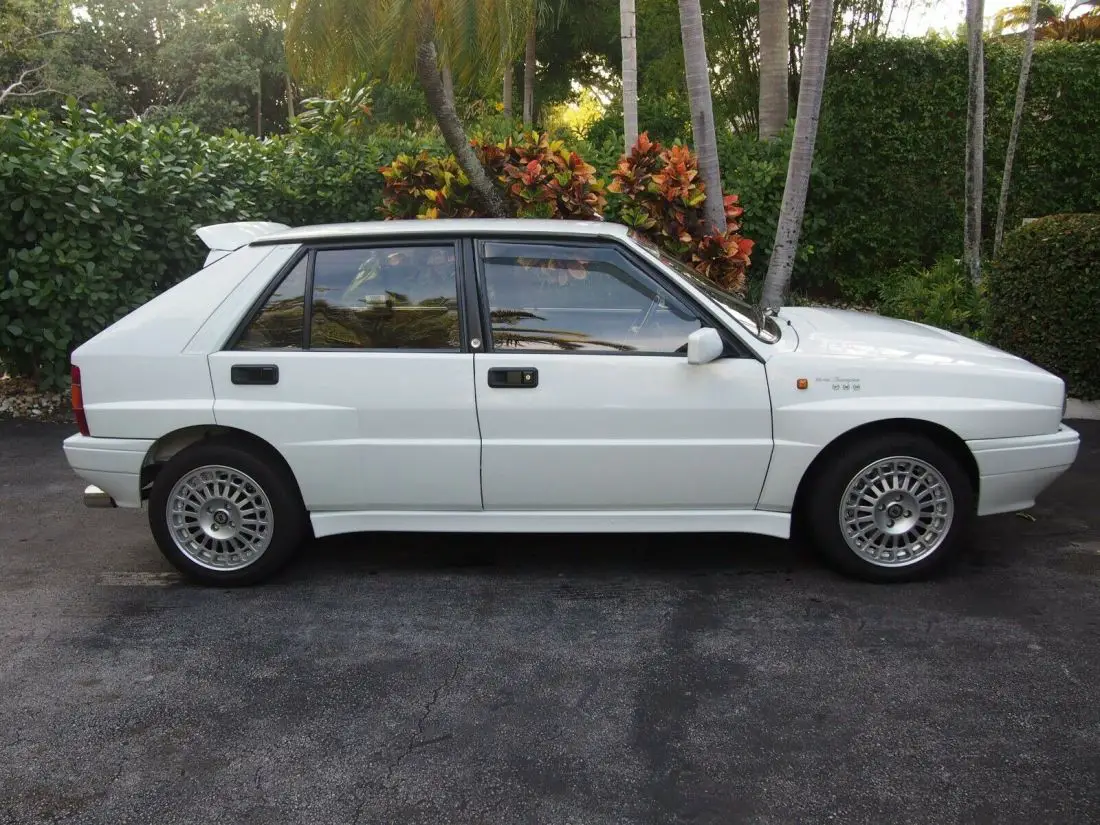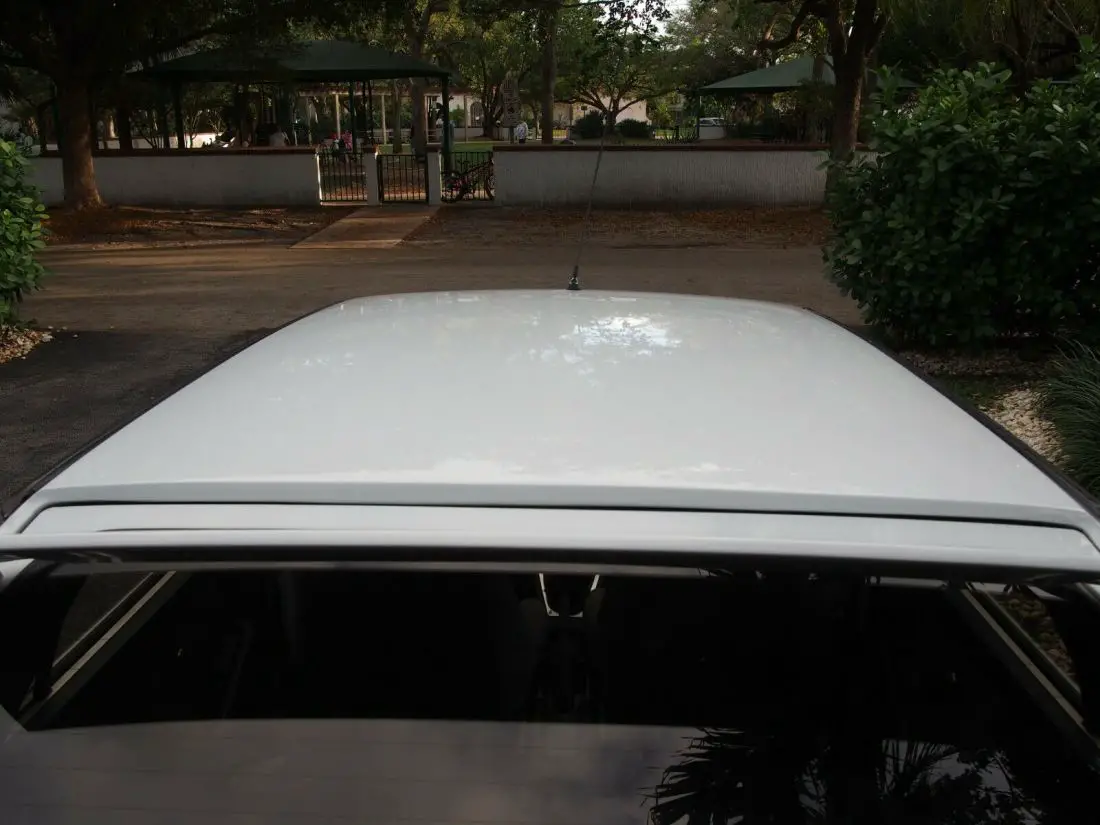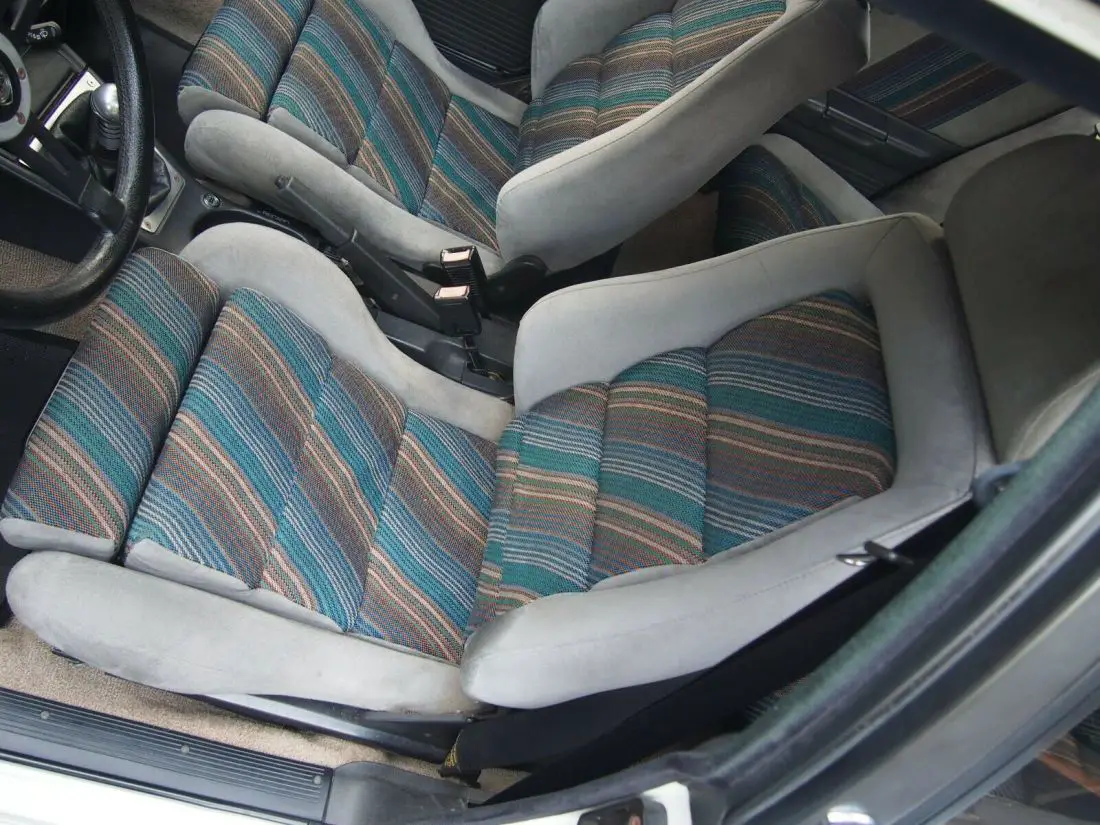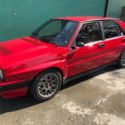1990 LANCIA DELTA ITEGRALE HF 16v
| Make: | Lancia |
| Model: | Delta |
| SubModel: | HF |
| Type: | Hatchback |
| Trim: | Integrale |
| Year: | 1990 |
| Mileage: | 47600 |
| VIN: | 00000000000000000 |
| Color: | White |
| Engine: | 2.0 Liter Turbo DOHC |
| Cylinders: | 4 |
| Fuel: | Gasoline |
| Transmission: | Manual |
| Drive type: | 4WD |
| Interior color: | Gray |
| Drive side: | Left-hand drive |
| Vehicle Title: | Clear |
| Item location: | Miami, Florida, United States |
1990 Lancia Delta Integrale Additional Info:
1990 Lancia Delta HF Integrale 16V
1990 Lancia Delta HF Integrale 16V featured in white with grey Alcantara Recaro interior.
A road-going descendant of Lancia's world rally championship dominating cars (6 times world champion from 1987-92), the Delta HF Integrale 16v featuresall-wheel drive, a front mounted engine and a Giugiaro-styled 5 door hatchback body style. The 2-liter engine is a turbocharged, double overhead camshaft, 4-cylinder unit that has an output of 215 bhp at 5750 rpm, and maximum torque of 231 lbft at 3500 rpm. The engine powers the wheels via a 5-speed manual transmission.
This car runs superb and turbo boost correctly at 1.1 bar (15 psi)
This Lancia was originally delivered in Spain and imported to the US in 2017 by me. It is a numbers matching engine and unmolesteddrive train.
It is all original and has never been modified, rallied or raced. The car has only 47,600 documented miles (76,200 Km).
This is not a Canadian-Japanese transplanted Lancia, this a true European model, I am the witness, I went to inspect the car to Spain before purchase myself.
VIN # ZLAB31AB000499937, This Lancia is fully titled (Clear) and registered in the great State of Florida, so no worriesall documents are in hand with additional service records.
I purchased this Lancia from the original owner in Spain (I am the 2nd owner), I have the original registration from 1990 and all import documentation.
This car is totally rust & accident free, since it came from a very dry climate from Southern Spain.
All services have been done since purchase that include:
- · Oil and Filter change (Mobil 1 15w50 with K & N filter)
- · Air and fuel filter
- · Spark Plugs
- · Spark plugs cables
- · Distributor cap and rotor
- · Driveshaft universal joints
- · Rear CV joints
- · Coolant service
- · Silicone Vacuum hoses
- · New battery
- · Turbo oil drain & Oil return hose for turbo
- · Water & Air Temperature sensors)
- · High pressure fuel hoses
- · Rear brakes compensation bushings
- · Fuel Pump relay
Newer Tires (Hankook Ventus V2 Concept) and wheels very new (less than 1250 miles), the interior is in perfect condition, no rips or marks and no sagging headliner.
Why buy this car instead of an EVO version?
- ·This is a lighter car with the same output motor of an EVO (After Free Flow Ragazzon tubular exhaust), rated at 215HP,
- · torque 231 lbt ft and a
- · zero to 60 mph @ 5.7 sec,
- · weight of 1,250 Kg (2600 lbs).
- · Price of $40K versus $$100k+
- · Top speed 140 mph
Tasteful Upgrades
- · LED bulbs for dash lights, interior lights, headlamp/fog lamp & taillights
- · K & N Air and oil filter
- · Ragazzon Mild Steel custom tubular exhaust, from front to back, this is a free flow exhaust, the choice by Ferrari owners
- · Turbologic silicone vacuum hoses
- · Turbo Dump machined aluminum Group A valve
https://www.youtube.com/watch?v=moSV4O-o1DM
https://www.youtube.com/watch?v=QJYYG-Y3D_k
https://www.youtube.com/watch?v=n9eRgQ79JuI
https://www.youtube.com/watch?v=DJhgU4Ul-zI&t=13s
This Lancia Delta Integrale is “Turn Key”, ready to be enjoyed and as close to pristine as possible, of course my description to pristine may not be as yours, therefore I encourage you the buyer to make and appointment and inspect he car by calling me, Bernie, “the owner” at 305 801 3884.
LANCIA DELTA INTEGRALE HISTORY
Thefirstevolutionarystepof theDelta HF 4WDwas presented at theFrankfurt Motor Showin September 1987: renamed Delta HF Integrale, it was updated in some details, both stylistic and mechanical.Externally the new version was recognized for the widened mudguards, the new design of bumpers and side skirts, the new front air intakes and on the bonnet, the 15-inch rather than 14-inch alloy wheels.
This version of theLancia Deltawas presented in October 1987 with the specific purpose of participating inthe World Rally Championshipstarting fromthe 1988 season.The car was a direct evolution of the Delta HF 4WD, a model that had successfully participated in the1987 edition bymonopolizing the brands and drivers titles, the latter withJuha Kankkunen.
After repeating both worldrallytitlesin 1988, the Delta HF Integrale "8v" - as it will be unofficially identifiedlater- was further improved the following year thanks to the introduction of the new engine with 4-valve distribution per cylinder: now called officially Delta HF Integrale 16v, made its debut at the end ofthe 1989 championship, atthe Sanremo Rally, where thanks to the outgoing championMiki Biasionhit a memorable victory after an extraordinary comeback onAlex FiorioandCarlos Sainz.The car continued to reap repeat successes throughout the next two years.
A few weeks after the successful conclusion ofthe 1991 seasonon the English dirt tracks of theRAC Rally, on 18 December Lancia announced his retirement from racing,despite the fact that a further update on a Delta basis was already ready.For 1992, it was decided to manage all the materials of the official racing department atMartini Racing, which from a historicsponsorbecame a realteamthanks to the technical support of theJolly Club, the most important satellite team Lancia del tempo is already present in a semi-official capacity for several years in rallies.
The Delta HF Integrale "Evoluzione" of theJolly Club, inRepsollivery, with whichCarlos Sainzparticipated in the1993 world championship.
The1992 seasontherefore saw the debut of the Delta HF Integrale "Evoluzione":the insufficient appellation stressed being in front of a car completely renewed compared to its ancestors, especially as regards the geometry of the suspension.Although not officially followed by the parent company,was clearfrom the first specialstages of the Monte Carlo Rallythat it would still be theDeltona- nickname with which it will become colloquially known among fans - the car to beat during the championship.The Turin berlinetta finished on the podium in all ten races entered in the constructors' championship, winning eight successes and four braces;at the end of the year the sixth consecutive marque title arrived for Lancia, while in the drivers' championship Kankkunen andDidier Auriolclosed second and third respectively, after a daring season finale that gave Sainz the title.
The presence of the Delta of the Jolly Club was confirmed also for the1993 championship: even with the disengagement of Martini, who passed the baton toRepsol, there was the engagement of the reigning world champion Sainz and the fast but still immatureAndrea Aghini.The Italian cars, although they had not been updated for almost a year as well as the introduction of new regulations (which foresee the use of narrower tires and the increase of the minimum weight), still remained sufficiently competitive;however the numerous accidents that occurred to his two drivers did not allow to demonstrate the potential of the car.At the end of the year, therefore, with only a few sporadic podiums in the game bag, Delta's career in the world rally ended definitively.
In 1995 the DeltaEvoachieved two more victories in the 2 liter FIA world rally championship, at theAcropoliswith Aris Vovos and inArgentinawithJorge Recal
The successes in the Rally World Championship
The Lancia Delta HF Integrale dominates the scenes of the World Rally Championship, resuming, without interruption, the success streak started in1987by theLancia Delta HF 4WD.To the world titles drivers and manufacturers won in 1987 are added another 6 consecutive Constructor Rally World Championships (from 1987 to 1992) and 3 Drivers Rally World Championships among which the two laurels ofMiki Biasion, first Italian, and at the moment stand out unique, capable of winning the coveted world title reserved for drivers.Only in1990and1992the Drivers' Championship was not the preserve of a Lancia driver: on both occasions it was conquered by the SpaniardCarlos Sainz.
6 seasons in the World Rally Championship the Lancia totals46 victories: the loot collected by the Delta HF Integrale alone in its various evolutions counts35 victoriesand96 podiums
Thestreet version of theDeltona
Details of the successes of the various models of the Delta HF Integrale in the World Rally Championship are given below:
· Lancia Delta HF Integrale "8v":
Wins: 14
Podiums: 18 in 1988 (2 doubles and 3 triplets) and 17 in 1989 (4 triplets)
Debut: Portugal Rally 1988
· Lancia Delta HF Integrale 16v:
Wins: 13
podiums: 1 in 1989, 16 in 1990 (1 double and 1 triple) and 20 in 1991 (1 double and 1 triple)
Debut: Sanremo Rally 1989
· Lancia Delta HF Integrale "Evoluzione":
Wins: 8
Podiums: 21 in 1992 (4 braces) and 3 in 1993
Debut: Montecarlo Rally 1992
More History
“The most prepared company for the transition from Group B to Group A racing was Lancia. Their determination to stay on top of the field can be seen not only in the evolution of the Delta race car, but the road car as well”.
From 1987 to 1992, Lancia consecutively won the Group A manufacturers championship, a record which holds to this day. With these results, Lancia have made the Integrale one of the most successful rally cars ever – a legendary car of our time.
All cars after 1989 have a 16 valve head, larger fuel injectors and a slightly revised compressor. Specifically, the turbine is smaller on the turbocharger, but the waste gate is modified to provide a larger boost. These 16V examples provide 200 bhp, fifteen more hp than the eight valve design.
Since, no modifications were permitted to the body of the car Group A car, the Integrale features the same body as used on the rally car. It combines Giorgio Guigaro’s five door layout with purposeful modifications including extended wheel arches, and modified bumpers and a 1.2 inch power bulge on the hood.
When compared to the standard Delta chassis, the Integrale features larger brakes, and an updated suspension including new front springs, dampers struts. What remains identical is the proven drive train which helped the Delta HF 4WD dominate Group A rally. The secret to the Delta’s sporting performance is its permanent four wheel drive system. It uses a Ferguson layout, having three differentials. At The rear is Torsen, or torque sensing, differential which mechanically splits the power in a linear fashion. The Torsen differential delivers instantaneous lock upon high loads and not during braking like viscous couplers. Such a differential is very expensive, any seldom seen on any 4WD production cars.
At the center of the 4WD system is a viscous coupling differential which divides the torque to the front or rear wheels. Under normal conditions, 53 percent of the power is sent to the rear wheels.
Despite such a complex drive train, the engineers at Lancia still opted for optional ABS on the Integrale. They revised Bosch’s six-sensor system by adding two additional sensors to measure longitudinal and transverse acceleration. Only under severe yaw does the ABS system intervene.
As Lancia was and still is owned by Fiat, it should be no surprise the Integrale uses a two liter Fiat engine as designed by Aurelio Lampredi. Updated in almost every area, the Integrale’s engine is an evolution of one found in the early Delta HF Turbo.
In 1991, Lancia issued an updated version of the Integrale 16V called the Evoluzione. Primary motivation for the Evoluzione came from Rally, where Abarth run Integrales needed modifications that had to be homologated. What really sets the Evoluzione apart from earlier cars was its body. Both the front and rear track were increased, as were the wheel arches, to comply with Rally Regulations stating that the tires could not extend beyond the body. A rear spoiler was also added to the top of the tailgate to improve airflow.
Under the skin, many changes were introduced to the brakes and suspension to increase endurance and stress tolerance. Specifically, the brake calipers were fixed and featured twin pistons instead of the single piston, floating calipers used on the earlier models. Other less significant changes included, smaller more powerful elliptical headlights, colored instrumentation, a front aluminum strut brace, a larger steering box and a remapped engine that produced 215 bhp.
MORE PICTURES
























